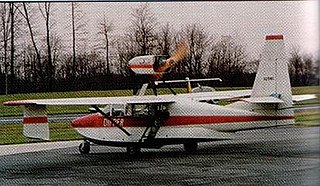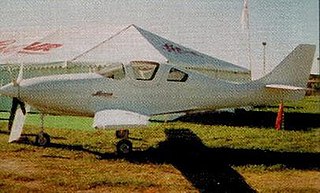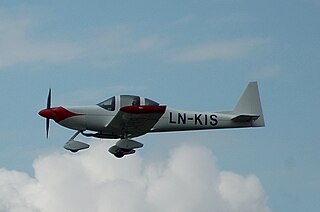
The Douglas D-558-2 Skyrocket is a rocket and jet-powered research supersonic aircraft built by the Douglas Aircraft Company for the United States Navy. On 20 November 1953, shortly before the 50th anniversary of powered flight, Scott Crossfield piloted the Skyrocket to Mach 2, or more than 1,290 mph (2076 km/h), the first time an aircraft had exceeded twice the speed of sound.

The Lancair ES is an American amateur-built aircraft that was designed and produced by Lancair. While it was in production the aircraft was supplied as a kit for amateur construction.

The Auster J/1U Workmaster is a late 1950s British single-engined single-seat high-wing agricultural monoplane built by Auster Aircraft Limited at Rearsby, Leicestershire. Of traditional high-wing layout, it carries 90 gallons of spray fluid in a tank beside the pilot, an extra seat being provided for a passenger. The Lycoming 0-360-A engine of 180 h.p. driving a McCauley v.p. propeller giving it ample power; and slotted ailerons and balanced tail controls providing good handling. Oversize tyres were fitted. Take-off run at 2,550 lb gross weight and cruising speed at 65 per cent power are respectively 180 yd and 88 miles per hour (142 km/h). Britten-Norman spray gear was provided by Crop Culture, and this company ordered nine Workmasters.

The MacFam Cavalier is a homebuilt aircraft designed by Stan McLeod, developed through a progressing series of models, all using all-wooden construction. The model range includes the SA102, SA102.5, SA103, SA104 and the SA105.

The Trident TR-1 Trigull is a Canadian amphibious aircraft that was developed by Trident Aircraft of Burnaby, British Columbia and later Sidney, British Columbia. The aircraft was intended to be supplied as a complete ready-to-fly certified aircraft. The company encountered financial difficulties and only three prototypes were ever built.
The Pro-Composites Vision is an American amateur-built aircraft, designed by Steve Rahm and produced by Pro-Composites of Buffalo Grove, Illinois. The aircraft is supplied in the form of plans for amateur construction, with some pre-formed parts made available to speed construction.
The Harmon Der Donnerschlag is an American homebuilt aircraft that was designed and produced by Harmon Engineering of Howe, Texas. The aircraft was intended for amateur construction.
The Harris Geodetic LW 108 is an American homebuilt aircraft that was designed by J. Warren Harris of Vernal, Utah and made available in the form of plans for amateur construction.
The Merkel Mark II is an American homebuilt aerobatic biplane that was designed by Edwin Merkel and produced by the Merkel Airplane Company of Wichita, Kansas in the form of plans for amateur construction.
The Southern Aeronautical Renegade is an American Formula V Air Racing homebuilt aircraft that was designed by Charles Lasher and produced by Southern Aeronautical Corporation of Miami Lakes, Florida. The aircraft was supplied in the form of plans for amateur construction, but the plans are apparently no longer available.
The Sawyer Skyjacker II is an American homebuilt aircraft that was designed and produced by Ralph V. Sawyer of Lancaster, California, in 1974. The aircraft was intended as a research project and as such only one was built.
The Rogers Sportaire is an American homebuilt aircraft that was designed David M. Rogers and produced by Rogers Aircraft of Riverside, California, introduced in 1959. The aircraft was supplied in the form of plans for amateur construction, but plans are no longer available. Only one was built.
The Williams-Cangie WC-1 Sundancer is an American homebuilt biplane racing aircraft that was designed by Art Williams and Carl Cangie and built by Ralph Thenhaus in 1974. Plans were at one time available from Williams' company, the Williams Aircraft Design Co of Northridge, California. Only one was built.
The Bagalini Bagalini is an Italian homebuilt ultralight aircraft that was designed by Marino Bagalini. The aircraft is supplied in the form of plans for amateur construction.

The Collins Dipper was an American homebuilt flying boat that was designed and produced by Collins Aero of Chadds Ford, Pennsylvania and first flown in 1982. The aircraft was supplied in the form of plans for amateur construction. Only one was built and none remain registered.
The Historical PZL P.11c is an American homebuilt aircraft that was designed and produced by Historical Aircraft Corporation of Nucla, Colorado. The aircraft is a 66% scale replica of the Polish PZL P.11c fighter and when it was available was supplied as a kit for amateur construction.

The Lancair Tigress was an American homebuilt aircraft that was designed by Lance Neibauer and intended for production by Lancair of Redmond, Oregon. Introduced in mid-late 1990s, it was essentially a Lancair IV with a much more powerful engine. When the engine was cancelled just as it was entering production, the Tigress project ended with it. Only prototypes were produced.
The Starfire Firebolt, sometimes called the Starfire Firebolt Convertible, due to its removable canopy, is an American homebuilt aerobatic biplane that was designed by G. H. "Mac" McKenzie and produced by Starfire Aviation of Tempe, Arizona. When it was available the aircraft was supplied in the form of plans for amateur construction, with some pre-fabricated parts available.

The Tri-R KIS TR-1 is an American homebuilt aircraft that was designed by Rich Trickel and produced by Tri-R Technologies of Oxnard, California, introduced in the 1990s. When it was available the aircraft was supplied as a kit for amateur construction.
The American Homebuilts John Doe is an American STOL homebuilt aircraft that was designed by Steve Nusbaum and produced by American Homebuilts of Hebron, Illinois, first flown in 1994. When it was available the aircraft was supplied as a kit for amateur construction.








